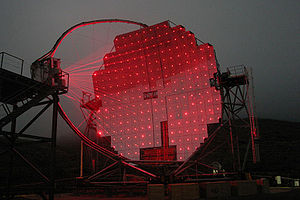This article includes a list of references, related reading, or external links, but its sources remain unclear because it lacks inline citations. (March 2024) |

IACT (imaging atmospheric [or air] Cherenkov telescope[1] [or technique][2][3]) is a device or method to detect very-high-energy gamma ray photons in the photon energy range of 50 GeV to 50 TeV.
As of 2017, there are four operating IACT systems: High Energy Stereoscopic System (H.E.S.S.), Major Atmospheric Gamma Imaging Cherenkov Telescopes (MAGIC), First G-APD Cherenkov Telescope (FACT), and Very Energetic Radiation Imaging Telescope Array System (VERITAS). The Major Atmospheric Cerenkov Experiment Telescope (MACE) is under construction in Hanle, Ladakh, India and is set to be the highest and second-largest IACT. The Cherenkov Telescope Array (CTA) is a multinational project to build next-generation IACTs and is scheduled to begin data collection in 2022.[4]
- ^ "MAGIC telescopes webpage". Archived from the original on 2012-05-11. Retrieved 2012-06-15.
- ^ "H.E.S.S. experiment webpage". Retrieved March 5, 2024.
- ^ "VERITAS webpage". Archived from the original on 2014-11-03. Retrieved 2012-06-15.
- ^ "A brand new technique to research high-energy gamma rays | Internet Shots". Retrieved 2019-11-03.